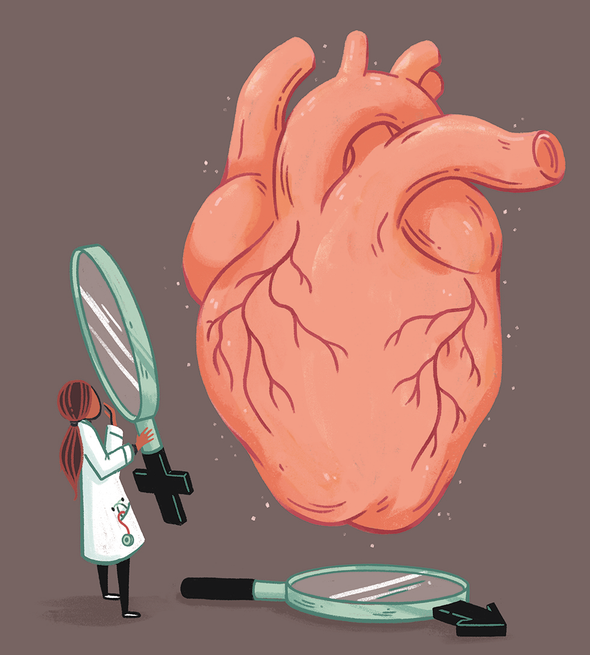Consider almost everything you know about heart disease, particularly the garden-variety type involving high cholesterol levels, clogged coronary arteries, stents and bypass surgeries. Now I want you to rebrand all that as “male-pattern” cardiovascular disease. That's how some researchers are reframing it after taking a closer look at heart disease in women.
For years cardiologists were baffled as to why up to half of women with classic symptoms of blocked vessels—chest pain, shortness of breath and an abnormal cardiac stress test—turn out to have open arteries. Doctors called it “cardiac syndrome X.” They didn't understand it, and many women were subjected to repeated angiograms in search of blockages that weren't there.
That still happens today, but more doctors now recognize that despite having open arteries, about half of women with this pattern nonetheless have ischemia—poor blood flow through the heart. The condition has gained a mouthful of a name: ischemia and no obstructive coronary artery disease, or INOCA.
Cardiologist C. Noel Bairey Merz has spent more than 20 years overseeing the Women's Ischemia Syndrome Evaluation (WISE) study, aimed at demystifying INOCA and related conditions. Although male-pattern disease is the most prevalent type in both sexes, “INOCA probably comprises 25 to 30 percent of ischemic heart disease in women and 10 percent in men,” says Bairey Merz, director of the Barbra Streisand Women's Heart Center at Cedars-Sinai's Smidt Heart Institute. WISE data show that after diagnosis, women with the disorder face a 2.5 percent annual risk of dying, suffering a nonfatal heart attack or stroke, or being hospitalized for heart failure. They are also four times more likely than men to be readmitted to a hospital within 180 days of being treated for a heart attack or severe chest pain.
The initial mystery of INOCA was how the heart could be starving for blood if its main arteries are not blocked. The answer often lies in the smaller branches and twigs of the vascular system—arterioles and capillaries that deliver oxygen and nutrients to heart muscle. The walls of these vessels are too thin to accumulate plaque, but they can become dysfunctional, failing to contract or dilate as needed—when, for example, someone is walking up a flight of stairs or is hit by an emotional shock.
Half to two thirds of INOCA cases can be traced to such dysfunction, which is detected with specialized scanning or testing via catheter. Why women are so susceptible is not fully known, says cardiologist Puja K. Mehta of Emory University's Women's Heart Center. Many of the usual suspects are implicated—smoking, diabetes, high blood pressure, high cholesterol—but a history of problems during pregnancy, such as elevated blood pressure and diabetes, and of depression and autoimmune diseases, both of which are more common in women, may also contribute.
Optimal therapy remains a work in progress. Smallish studies show that many drugs used to treat male-pattern disease, including statins and ACE inhibitors, can help patients with INOCA. The first truly large-scale trial comparing an intensive drug regimen with “usual care” in 4,422 women got underway in early 2018. Its results, due out in 2022, should help set treatment standards.
Effective therapy is badly needed. Women with microvascular dysfunction often go on to develop heart failure. And not just any heart failure but a particularly female version. In men, the typical problem is that the ventricles don't squeeze effectively; this is called heart failure with reduced ejection fraction, or HFrEF (pronounced “hef-ref”). In women, the more frequent issue is that the ventricles don't relax enough to fill properly; this is heart failure with preserved ejection fraction, or HFpEF (“hef-pef”).
Both types are rising in the U.S. because the population is getting older, fatter and more diabetic. As cardiologist Linda Peterson of the Washington University School of Medicine in St. Louis notes: “More people survive their heart attacks, so they are dying of heart failure down the road.” HFrEF is well understood. “We have buckets of knowledge and treatment for [it],” Bairey Merz says, “but essentially no effective therapy for HFpEF. Had we studied women 50 years ago, we wouldn't be in this situation.”
Just about everything we know about heart disease in women has been learned since the early 1990s, when the National Institutes of Health began requiring that women be included in the studies it funds. Before that, most medical research was conducted on guys: male patients, male rats, male mice, male monkeys, male cells. Like most gender gaps, this one is closing slowly.


